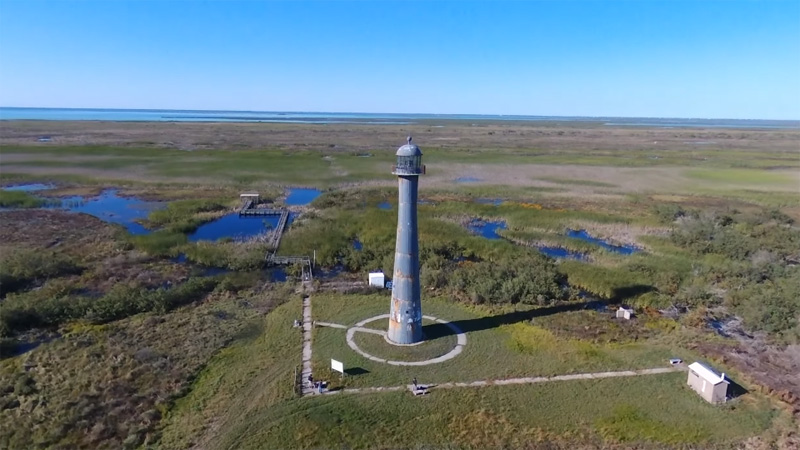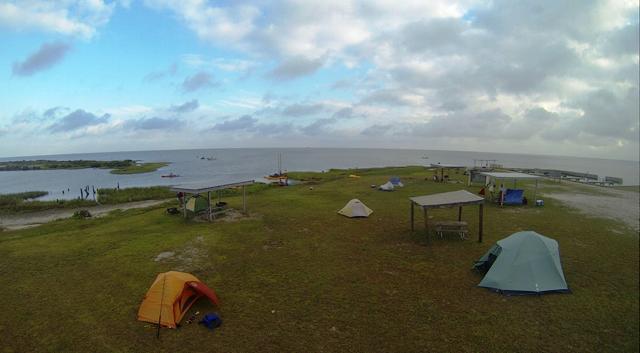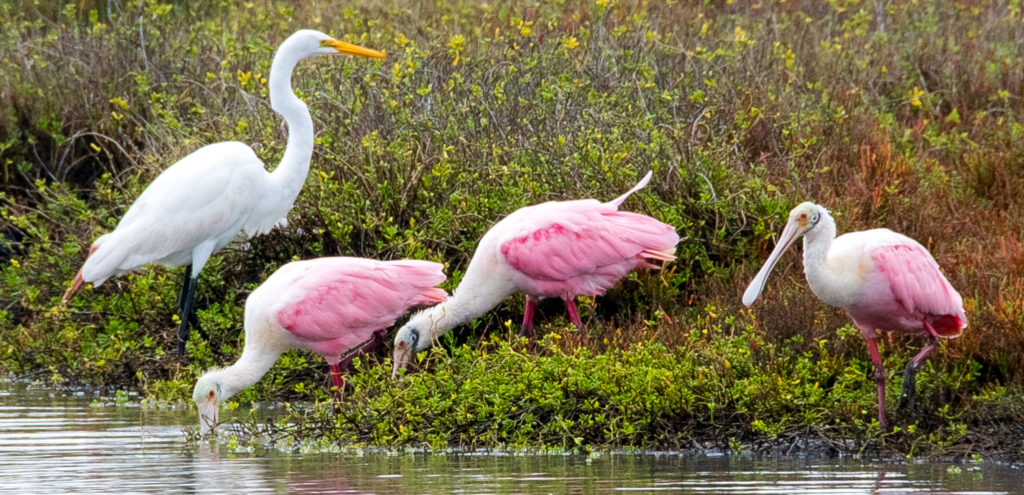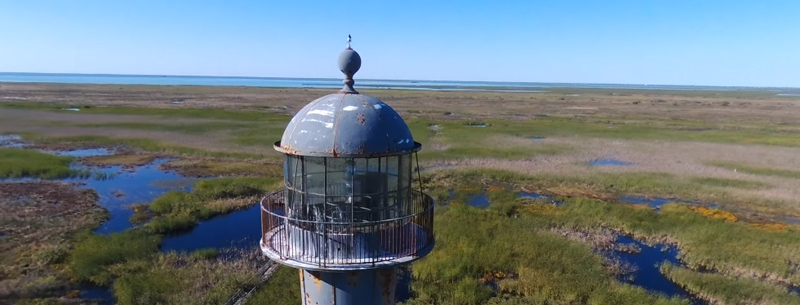Matagorda Island State Park
Matagorda Island State Park and Wildlife Management Area, in Calhoun County, is separated from the mainland by San Antonio and Espíritu Santo bays and is one of the barrier islands that border the Gulf to protect the mainland from the great tides and strong wave action of the open ocean.
The park and wildlife management area occupies about 43,893 total acres; the parking area is approximately 7,325 acres. Under a cooperative agreement between the US Department of the Interior and the State of Texas approved in 1983, the entire area of public lands is managed by the Texas Parks and Wildlife Department. (The southwestern tip of the island, consisting of approximately 11,500 acres, is operated by the US Fish and Wildlife Service.)

Matagorda Island did not exist until about 5000 years ago, but it is rich in history. Prehistoric and the much later Karankawa Indians used the island until they were driven off by European settlers. Often six feet tall, carrying giant bows, and covered with dirt and alligator grease to repel mosquitoes, the Karankawas appeared fierce and imposing to the Europeans. Historical highlights include visits by Cabeza de Vaca, René Robert Suer de La Salle, and Jean Lafitte.
The island featured prominently in the growth of Texas in the 1800s. Traces of the past activity can be found at the civil war trenches, an abandoned Air Force base, an 1852 vintage lighthouse, and the now-submerged Fort Esperanza. Major storms of the 1800s and 1900s destroyed many area towns and slowed economic growth, but now the area is becoming known as an outdoor enthusiast’s paradise.
The park is open 7 days a week year-round.
Things to do on Matagorda Island
The Matagorda Island State Park offers visitors a large variety of attractions. Whether you enjoy land-based and or water-based activities, or if you wish to study the natural history of the area; the park caters adequately to each desire.

For nature enthusiasts, nineteen species listed by federal or state government as threatened or endangered are found here, including the whooping crane, peregrine falcon, brown pelican, Ridley sea turtle, and horned lizard. The island marshes are important nursery areas for shrimp, oysters, blue crabs, and many sportfishing species, such as red drum, spotted sea trout, tarpon, shark, mackerel, and southern flounder.
Wildlife
Very few amphibians are found on Matagorda Island. The most common ones include leopard frog, bullfrog, and gulf coast toad. Over 30 species of reptiles occur on the island. The largest is the American alligator. Of the 19 species of snakes, the most frequently encountered include the western diamondback rattlesnake, a speckled king snake, and the western coachwhip. More than 300 species of birds use the island, many during spring and fall migrations. Barrier islands do not support large numbers of mammals; the most common are white-tailed deer, coyotes, raccoons, badgers, and jackrabbits. The most common marine mammal is the bottle-nosed porpoise.
Beach Camping
Facilities include primitive camping on the Beach Campground, which is a two-mile stretch of Gulf beach, 3.5 miles from the boat dock, is serviced by the island shuttle and has covered picnic tables.

The Army Hole Campground, on the bay a few yards from the boat dock, has shaded picnic tables, fire rings, pit toilets, and an outdoor, cold-water shower.
Recreation
Activities include camping, hiking, bicycling, surfing, swimming, beachcombing, bird watching, nature study, fishing, a passenger ferry, on-island shuttle, and scheduled tours. Additionally, staff-conducted historical and natural history programs are available. Please contact the park for a current schedule or to set up a group program. There are island tours given by park staff, and a discount is offered to holders of a Texas Conservation Passport. Tour fees apply.

Matagorda Bay Fishing
Fishing is a part of life in Matagorda Bay, and most residents go out on foot and stroll to the most profitable waters. It’s a way of life in this region of the state, and if you want a real experience, here is the place to go. Because the waters are shallow here, wading across them while casting your line is a popular pastime.
Jetty Park
Jetty Park is the perfect spot for all your fishing and SUP adventures! This paradise sits at the entrance of the Colorado River, just across from the beach. Its calm waters are ideal for paddling around and enjoying the day with friends. Despite this, be sure to keep an eye out for speeding boats; this is an active boating channel that can quickly become hazardous if you’re not careful. Jetty Park is the perfect choice for a fun and relaxing fishing adventure. So pack up your cooler, grab your rods and get ready to explore this majestic bay in search of your next big catch!
Oyster Lake Park
Are you looking for the perfect spot to relax and cast your rod? The hidden gem of Oyster Lake Park may be the answer. Located at the end of Oyster Lake Road, this small park offers unparalleled access to both West Matagorda Bay and Oyster Lake. And, with its tranquil setting, it’s no wonder that the park is one of the sites on The Great Texas Birding Trail. Whether you’re a pro angler or just testing out a new hobby, you’ll find plenty of parking where you can pull up and get ready to make some waves. Don’t miss the opportunity to experience one of the best fishin’ spots!
Offshore Fishing
The waters around Matagorda Island are abundant with fish, including redfish, speckled trout, and flounder. Many local charter companies offer guided fishing trips for visitors.
Make a note to ask about these offshore fishing spots:
- Red Mountain
- Captain T Shrimp Boat Wreck
- Bubble Hole
- Wreck Inshore of Rig 538
- The Rubber Ship
Another fantastic approach to catching your fish without getting wet is to visit one of the bay’s piers. You’ll feel a sense of community because folks congregate at these locations for a day of sunshine and fun. The Port Lavaca State Fishing Pier is very popular, with fishermen traveling from all around Texas to visit. Or go surf fishing at the beautiful Magnolia Beach!
Matagorda Beach
Matagorda Beach is a massive 26-mile-long beach on the Texas coast near the mouth of the Colorado River. It’s a great area to spend time with your family, your pet, or even by yourself while enjoying nature and peace & quiet. Most of the time, it is not at all crowded. On weekdays, you may have the entire beach to yourself!
The beach is pristine and uncrowded. On weekdays, you may take delightful walks along the seashore, with wailing seagulls and the smell of saltwater. You can also bring your dog with you. A lengthy pier is available for strolling or fishing.
The beautiful beach at Matagorda Island is a great place to go swimming, but check the conditions before diving in. Be especially cautious near jetties, piers, passes, and the mouths of rivers like Mitchell’s Cut and the Colorado River; these areas often have swift currents that can be fatal if you get stuck in them. Even on a seemingly calm day, strong rip tides can lurk beneath the surface, so it’s important to know what to do if you start to get pulled out. If you feel caught in a current, remember to stay calm and swim sideways to try and escape.
Don’t hesitate to ask a local if you’re ever in doubt about the wave or water conditions. The people in Matagorda are known for their friendly attitudes and will be more than happy to advise you – much better than risking an outing gone wrong due to an unexpected riptide ripping you away from shore.
Because seaweed is scraped up on a regular basis, there isn’t much in the water. The beach is ideal for wading and shelling; your children will have a fantastic time here! However, if you wish to swim, make sure you’re quite far away from the spot where the river meets the gulf, as rip currents can form there.
Climate
Matagorda Island State Park is located at an elevation of 0-22 feet. Temperatures within the park range from an average January minimum of 46 degrees and an average July maximum of 91 degrees. The average rainfall is 43.2 inches. Current weather conditions can vary from day to day. For more details, call the park or Park Information at 1-800-792-1112.
Location
Matagorda Island State Park is situated within the Gulf Coast region of Texas. The headquarters is in Port O’Connor at the intersection of 16th Street and Maples. The only access is by boat; the Matagorda Ferry is a 50-foot, aluminum-hull boat certified to transport 49 passengers that operate on Thursday, Friday, Saturday, and Sunday. There is a fee, and surfboards and bicycles are allowed on the ferry which departs from Port O’Connor. A shuttle fee is charged to visitors who bring their own boat, which is included in the visitors’ ferry fee. Contact the park for ferry schedule/use detail.
Matagorda Island State Park, 16th Street and Maples, Port O’Connor TX, 77982, Phone: 361-983-2215
